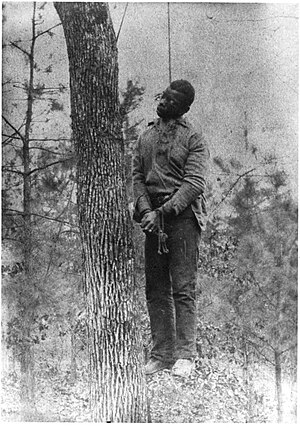Lynching
 |
This article's content is marked as Mature The page Lynching contains mature content that may include coarse language, sexual references, and/or graphic violent images which may be disturbing to some. Mature pages are recommended for those who are 18 years of age and older. If you are 18 years or older or are comfortable with graphic material, you are free to view this page. Otherwise, you should close this page and view another page. |

| “ | We of the South have never recognized the right of the negro to govern white men, and we never will. We have never believed him to be the equal of the white man, and we will not submit to his gratifying his lust on our wives and daughters without lynching him. | „ |
| ~ Benjamin Tillman, a notorious white supremacist, attempts to justify lynching of African-Americans. |
Lynching is a form of murder where a group of organized people kill one or a few people. The Ku Klux Klan is infamous for succeeding in perpetrating over 500 lynches in America. An infamous example in the Bible was the lynching of Stephen by many Jews.
Lynching is considered to be a hate crime.
History[edit]
Historically, the fehmic courts of medieval Germany imposed some punishments that involved lynching, as did the Halifax gibbet law (execution of those guilty of theft valued over a specific amount) and Cowper justice (trial after execution) in the border districts of England. Resembling these cases were the Santa Hermandad constabulary in medieval Spain and pogroms directed against Jews in Russia and Poland, although in these cases there was support from legally constituted authorities.
Vigilante justice has been practiced in many countries under unsettled conditions whenever informally organized groups have attempted to supplement or replace legal procedure or to fill the void where institutional justice did not yet exist. Such conditions commonly give rise to acts of genocide. Statistics of reported lynching in the United States indicate that, between 1882 and 1951, 4,730 persons were lynched, of whom 1,293 were white and 3,437 were black. Lynching continued to be associated with U.S. racial unrest during the 1950s and ’60s, when civil rights workers and advocates were threatened and in some cases killed by mobs.
A major motive for lynchings, particularly in the Southern United States, was the white society's efforts to maintain white supremacy after the emancipation of the enslaved people following the American Civil War. It punished perceived violations of customs, later institutionalized as Jim Crow laws, which mandated racial segregation of whites and blacks, and second-class status for blacks. A 2017 paper found that more racially segregated counties were more likely to be places where whites conducted lynchings.
Opponents of legislation often said lynchings prevented murder and rape. As documented by Ida B. Wells, the most prevalent accusation against lynching victims was murder or attempted murder. Rape charges or rumors were present in less than one-third of the lynchings; such charges were often pretexts for lynching blacks who violated Jim Crow etiquette or engaged in economic competition with whites. Other common reasons given included arson, theft, assault, and robbery; sexual transgressions (miscegenation, adultery, cohabitation); "race prejudice", "race hatred", "racial disturbance"; informing on others; "threats against whites"; and violations of the color line ("attending white girl", "proposals to white woman").
Although the rhetoric surrounding lynchings frequently suggested they were to protect the virtue and safety of white women, the actions basically arose out of white attempts to maintain domination in a rapidly changing society and their fears of social change.
Mobs usually alleged crimes for which they lynched Black people. In the late 19th century, however, journalist Ida B. Wells showed that many presumed crimes were either exaggerated or had not even occurred.